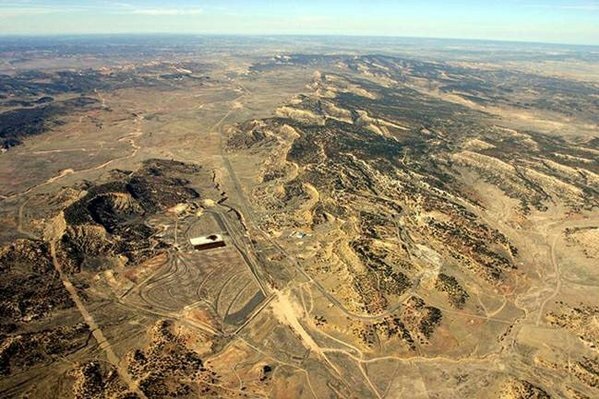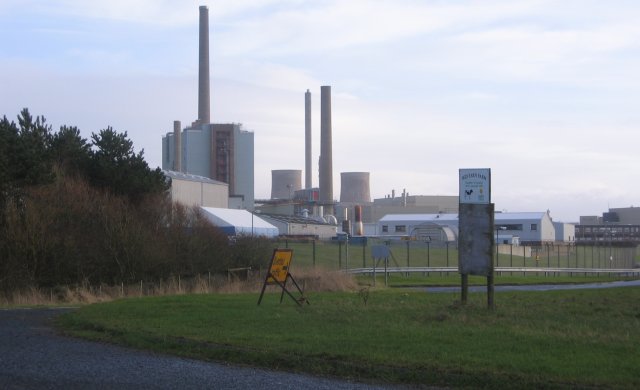Author: Burt Webb
-

Geiger Readings for Feb 21, 2019
Ambient office = 60 nanosieverts per hour
Ambient outside = 77 nanosieverts per hour
Soil exposed to rain water = 83 nanosieverts per hour
Blueberry from Central Market = 116 nanosieverts per hour
Tap water = 92 nanosieverts per hour
Filter water = 84 nanosieverts per hour
-

Radioactive Waste 382 – Cleanup Of Northeast Church Rock Mine and Mill on Navajo Nation Land
Problems with mining uranium do not get much coverage in the media. However, they pose a very serious threat to the environment both during the mining operation and for decades after the mine has been shut down.
The Northeast Church Rock uranium mine is located approximately seventeen miles northeast of Gallup, New Mexico. It is on the Pinedale Chapter of the Navajo Nation. Between 1967 and 1982, about three and a half tons of uranium ore were taken out of the mine. The ore from the mine was processed at the nearby Church Rock Mill under a license issued by the State of New Mexico.
Regulatory oversight for the mine has been carried out under a memorandum of understanding between the Nuclear Regulatory Commission and the Environmental Protection Agency since 1988. The NRC regulates surface reclamation and closure activities at the closed mine. The EPA regulates cleanup of the mine.
The waste pile at the mill has been temporarily covered and stabilized after over two hundred thousand tons of contaminated soil was removed from the residential areas near the mine and taken to the mine tailings impound area at the mill. The United Nuclear Corporation (UNC), a subsidiary of GE, applied to the NRC in the fall of 2018 for an amendment to the mine license to allow them to transfer a million cubic yards of mine spoils to the tailings impoundment facility at the nearby mill site.
EPA action level standards say that soil that contains two and a quarter picocuries per gram of radium-226 or two hundred thirty milligrams per kilogram of natural uranium or less are eligible to be transferred from the mine to the existing tailings impoundment area of the mill site. Any waste that contains two hundred picocuries of radium-226 or five hundred milligrams per kilogram of natural uranium or more would need to be segregated and moved to a licensed disposal facility offsite. UNC proposes building a cover over the tailings before the mine spoils are added to the pile. Then a final cover would be built over the mine spoils layer. The EPA has approved of this action in addition to other tasks at the mine and mill.
The Navajo Nation occupies more than twenty-seven thousand square miles in the states of Arizona, New Mexico and Utah. There are over two hundred and fifty thousand Navajos living in the Nation. Almost thirty million tons of uranium ore were extracted from Navajo lands between 1944 and 1986. This has left behind a horrible legacy of over five hundred closed uranium mines. Various U.S. federal agencies are cooperating to remove the greatest risks to the population of the Nation from the contamination that resulted from the mining operations on Navajo land. Since 1994, the Superfund Program has rendered technical assistance and funding to assess sites that may be contaminated and develop a response for those sites which are.
The U.S. EPA and the Navajo Nation EPA have designated forty-six of the five hundred closed mines as being priorities for cleanup. This designation is based on readings of gamma ray levels close to homes and water supplies. The Northeast Church Rock Mine has been given the highest priority for cleanup because of the number of people who live close to the mine. The public has until the 19th of April to give their comments on the NRC environmental review. The Commission with then draft an environmental impact statement of the actions proposed by UNC. -

Geiger Readings for Feb 20, 2019
Ambient office = 76 nanosieverts per hour
Ambient outside = 136 nanosieverts per hour
Soil exposed to rain water = 140 nanosieverts per hour
Avocado from Central Market = 60 nanosieverts per hour
Tap water = 102 nanosieverts per hour
Filter water = 97 nanosieverts per hour
-

Nuclear Reactors 657 – Congress Investigates Plans To Export Nuclear Technology To Saudi Arabia
I have blogged before about the Saudi Arabian quest for nuclear power. Major suppliers of nuclear technology are competing to supply Saudi Arabia with nuclear power reactors. However, there are concerns that Saudi Arabia might turn nuclear technology towards the development of nuclear weapons. This is a major impediment to the export of U.S. nuclear technology to Saudi Arabia.
A new report from U.S. House Oversight and Reform Committee claims that the Trump administration tried to rush the transfer of U.S. nuclear technology to Saudi Arabia in potential violation of the laws governing the export of U.S. nuclear technology. An interim staff report from the Committee quoted multiple whistleblowers who reported ethical and legal problems with the process.
The report says “They have warned about political appointees ignoring directives from top ethics advisers at the White House who repeatedly and unsuccessfully ordered senior Trump administration officials to halt their efforts. They have also warned of conflicts of interest among top White House advisers that could implicate federal criminal statutes.”
The report claims that the major promoters of the transfer of U.S, nuclear technology to Saudi Arabia were retired General Michael Flynn who was national security advisor to President Trump and Thomas Barrack who was the chair Trump’s inaugural committee. Flynn was fired in February of 2017 when he was found to have lied to the FBI about his conversations with the Russian Ambassador.
Flynn served as an advisor to IP3 International for about seven months in 2016. IP3 is a private company that was involved in negotiations to build nuclear power plants in Saudi Arabia. Flynn continued to promote IP3’s plans after he joined the Trump White House as National Security Advisor in early 2017.
Under the Atomic Energy Act, the U.S. Congress is required to approve the transfer of any nuclear technology to a foreign country. The report claims that Derik Harvey, a senior director at the National Security Council (NSC), insisted that the decision to sell nuclear technology to Saudi Arabia had already been made after ignoring warnings that such action would be illegal.
Lawyers for the NSC were aware that Flynn could have a conflict of interest with respect to the IP3 plans. They told the NSC staff to stop working on the IP3 planned transfer of U.S. nuclear technology to Saudi Arabia. However, even after Flynn was fired in February 2017, work on the plan appeared to continue with the support of Tom Barrack.
The House Oversight Committee has announced that it will carry out an investigation into nuclear technology transfer plans “to determine whether the actions being pursued by the Trump administration are in the national security interests of the United States, or, rather, serve those who stand to gain financially as a result of this potential change in U.S. foreign policy.” The House Intelligence Committee has said that it will coordinate with the Oversight Committee on investigation of this matter.
The White House has not yet responded to requests for their comments on these investigations and reports. -

Geiger Readings for Feb 19, 2019
Ambient office = 106 nanosieverts per hour
Ambient outside = 128 nanosieverts per hour
Soil exposed to rain water = 130 nanosieverts per hour
Beefsteak tomato from Central Market = 108 nanosieverts per hour
Tap water = 99 nanosieverts per hour
Filter water = 89 nanosieverts per hour
-

Radioactive Waste 381 – Radioactive Effluents From Nuclear Facilities On Coasts Are Blown Back Onto Land By Prevailing Winds
There are a variety of problems involving nuclear power and water. One big issue is the fact that bodies of water are becoming too hot in some cases to be used to cool nearby nuclear reactors. Another problem is simply falling levels of water that are needed for cooling. Major hurricanes that might damage nuclear power plants are a third concern. Today, I am going to address a problem that just came to my attention.
Effluents containing radioactive particles are discharged into the ocean around the world from nuclear power plants, nuclear fuel fabrication facilities and nuclear fuel reprocessing facilities. These radioactive materials can be carried ashore in airborne spray and micro-droplets called marine aerosols. Flooding in such coastal areas would also carry radioactive materials onto the shores. In such places on coasts where the prevailing winds blow onto the shore, the problem is exacerbated.
The U.K. Atomic Energy Agency carried out research on this subject around 1980 in cooperation with the nuclear industry and pro-nuclear groups. They studied the sea to land transfer of five radionuclides including alpha emitters plutonium-238, plutonium-239, plutonium-240, americium-241 and beta emitters cesium-134 and cesium-137. They found that all five of these radionuclides were being carried onto shore by the wind blowing off the ocean.
In winds of less than twenty-two miles per hour, cesium was taken up in spray and marine aerosols and moved onto land. The amount of cesium in the spray and aerosol was about double that of normal ocean spray and aerosols. On the other hand, the level of alpha emitting plutonium and americium in the studied areas were hundreds of times higher than in uncontaminated sea water. These alpha emitters adhered to micro particles of sedimentary and organic materials that are normally suspended in the marine water column. They were ejected into the atmosphere both as aerosols both by bursting bubbles and the surf line along the coast.
Once this behavior of radioactive particles in the sea was confirmed, the research was stopped. Since then, no empirical studies have been carried out by “official” U.K. agencies into inland penetration of radioactive spays and aerosols as well as human exposure to these radioactive materials. There are over seventy different radionuclides discharged into the sea from U.K. nuclear facilities but only these five radionuclides were ever studied.
Airborne radioactive materials can travel up to ten miles inland. Human populations in these areas can inhale the particles. There is also a danger of human consumption of these radioactive materials where there are dairy and beef raising operations near the sea. Such materials could also be consumed from crops grown in these areas. Studies in the area of Sellafield in the U.K. show that people who eat local produce have higher levels of cesium-137 in their blood than people in the same area who eat non-local produce. People in these areas may even receive more cesium-137 from local produce that from sea food taken from the sea in that area.
It is logical to assume that the findings of the research in the U.K. also applies to the transport of radionuclides effluences in ocean spray and marine aerosols anywhere in the world where there are prevailing onshore winds near coastal nuclear facilities. However, there has been no other widely disseminated research on this subject anywhere other than the 1980 work U.K. It appears that the promoters of nuclear power and the regulatory government agencies around the world are not particularly interested in such research because it might upset the public.
